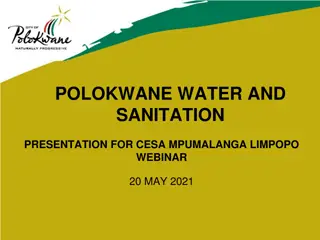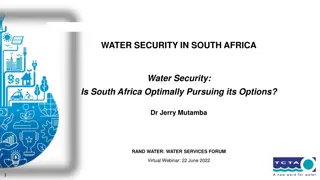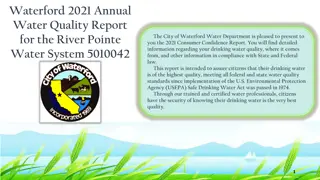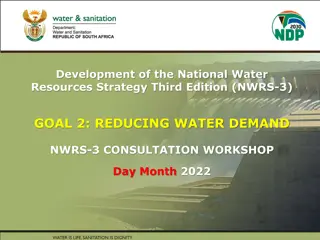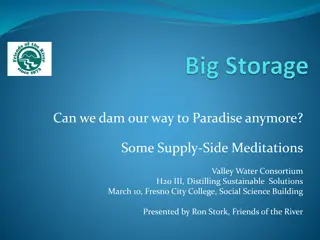Understanding Water Availability and Quality in South Africa
South Africa faces water scarcity due to low rainfall, with average rainfall at 450mm per year. Factors influencing water availability include dam construction, wetland destruction, temperature increase, farming practices, droughts, alien plants, and boreholes. Dams serve to stock up water and control river flow, supplying water for domestic and industrial use. Water is a renewable resource, but its availability is not always constant. There are four major river systems in South Africa, shared with neighboring countries, affecting overall water availability and quality.
Download Presentation

Please find below an Image/Link to download the presentation.
The content on the website is provided AS IS for your information and personal use only. It may not be sold, licensed, or shared on other websites without obtaining consent from the author. Download presentation by click this link. If you encounter any issues during the download, it is possible that the publisher has removed the file from their server.
E N D
Presentation Transcript
LIFE SCIENCES GRADE 12CAPS STRUCTURED, CLEAR, PRACTICAL - HELPING TEACHERS UNLOCK THE POWER OF NCS KNOWLEDGE AREA: Environmental Studies TOPIC 5: Human Impact on the Environment Water Availability and Water Quality
SUMMARY OF PRESENTATION Water Availability Factors that influence Water Availability Water Quality The Need for Water Purification and Recycle Impact of Alien Invasive Plants on Water Quality
WATER AVAILABILITY South Africa is describe as a water scarce country. It is called a water scarce country because it receives very little rainfall. The average rainfall received is 450mm per year. This is very low, it is about half the average rainfall of other countries. Most of the country is arid and semi arid. The amount of rainfall received for the different parts of the country is different. The west coast of the country is drier than the east coast. The dry conditions are also brought about by evaporation and a warm climate.
WATER AVAILABILITY Water is a renewable resource. Despite this freshwater is not always available. There are 4 major river systems in South Africa These are Limpopo Komati Maputu/Usuthu Orange River These river systems are shared with the neighboring countries. 1. 2. 3. 4.
FACTORS THAT INFLUENCE WATER AVAILABILITY In South Africa water availability is influenced by the following factors Construction of dams Destruction of wetlands Increased temperatures Poor farming practices Droughts and floods Alien plants and the depletion of the water table Boreholes and their impact on aquifers Wastage Cost of water We will now discuss these factors. 1. 2. 3. 4. 5. 6. 7. 8. 9.
FACTORS THAT INFLUENCE WATER AVAILABILITY Construction of Dams. 1. What is a dam? A dam is a man made barrier that is builtacross a river . Building of a dam leads to the formation of a lake or reservoir. A dam has two functions. These are To stock up water To control the flow of the river 1. 2.
FACTORS THAT INFLUENCE WATER AVAILABILITY The Main Purpose of a Dam The main purposes of a dam are as follows Supply of Water for Domestic and Industrial Use. During the rainy season water is collected and stored in the dam. This ensures that water is available throughout the year for both domestic and industrial use. This means that water is available all year round even the dry season. During the dry season water may also be released from the dam. a.
FACTORS THAT INFLUENCE WATER AVAILABILITY This makes water available for the plants and animals downstream that may not have water in the dry season. This is also useful for people living in informal settlements, because they are not supplied with municipal water. They have access to water all year round. Flood Control Dams can be used to regulate the flow of water. During heavy rainfall the volume of water within the river increases. The river can burst its banks. b.
FACTORS THAT INFLUENCE WATER AVAILABILITY The areas along the river banks will become flooded. This leads to great loss of both plant and animal life. The dam can be used to store the water and slow the release of water. The amount of water released can be controlled through the sluice control. This prevents flooding downstream.
FACTORS THAT INFLUENCE WATER AVAILABILITY Generation of Hydro-Electricity c. In this case water from a dam is used to generate electric power. This type of power is called hydro- electric power.
FACTORS THAT INFLUENCE WATER AVAILABILITY From the diagram we can see that the dam must be higher than the power station. Pipes carry the water from the reservoir to the power station. As the water falls it turns the turbines in the power station. In this way electricity is generated.
FACTORS THAT INFLUENCE WATER AVAILABILITY Irrigation d. Is when dry land is supplied with water using pipes ditches or streams. In dry areas irrigation can be used to supply water to the plants. Cotton crop being irrigated using a system of canals
FACTORS THAT INFLUENCE WATER AVAILABILITY During the rainy season water is collected and stored in the reservoirs or dams. During the dry season water can be distributed over the land using a system of pipes or canals.
FACTORS THAT INFLUENCE WATER AVAILABILITY Disadvantages of Constructing a Dam Loss of Biodiversity a. Construction of a dam leads to habitat destruction. Habitats both upstream and downstream are affected. Upstream- here the water is collected, this results in flooding of the habitat. This in turn leads to the drowning of many plant and animal species.
FACTORS THAT INFLUENCE WATER AVAILABILITY Down stream there is less water. Therefore the river banks dry out, resulting in the death of many species. When the flood sluices are opened then many of the remaining species drown. People and their Livelihoods are Affected. b. Many people depend on the river for their livelihoods. Some people use the river for farming, while other people use the river for fishing. Damming of the river results in less water downstream.
FACTORS THAT INFLUENCE WATER AVAILABILITY When the flood gates are open the river banks and sometimes the surrounding areas can flood. This result in a large number of people being displaced. Therefore they lose their homes and source of income. The Natural Balance of the River is Upset When a dam is constructed across a river lose soil is held back. This means that down stream the nature of the river is changed. c.
FACTORS THAT INFLUENCE WATER AVAILABILITY This affects all the plants and animals living downstream. Once again when the flood gates are open the river banks downstream are flooded. Plants die and animals are forced to leave the area. The river downstream can also become drier and this can lead to soil erosion. Under normal conditions during the rainy season the fertile soil is deposited on the river banks. The dams preventsthis from happening. Eventually the soil on the river banks downstream becomes less fertile.
TERMINOLOGY: TERM: Dam A Dam DEFINITION: USE IN SENTENCE: is a man made barrier that is built across a river . A dam is built across a river to stock water for domestic use.
TERMINOLOGY: TERM: Irrigation Irrigation DEFINITION: USE IN SENTENCE: Occurs when dry land is supplied with water using pipes ditches or streams. During the dry months of the year the farmers use irrigation to water their crops.
FACTORS THAT INFLUENCE WATER AVAILABILITY 2. Destruction of Wetlands A wetland is an area where the land is saturated by water. This maybe surface or ground water. Cape Lowland Freshwater Wetland
FACTORS THAT INFLUENCE WATER AVAILABILITY Characteristics of a Wetland: Waterlogged soil High water table Many aquatic plants Area is covered by water for a greater part of the year. o o o o Greater St. Lucia Wetlands
FACTORS THAT INFLUENCE WATER AVAILABILITY Some examples of wetlands are o Springs o Marches o Swamps o Floodplains Some examples of wetlands o Pans o Estuaries o Riverbanks and o Wet grasslands
FACTORS THAT INFLUENCE WATER AVAILABILITY The Role of the Wetland in an Ecosystem They purify the water by acting as a filter for pollutants found in the water. They are so successful as purifiers that artificial wetlands are being created to treat domestic and industrial waste. They storewater and are therefore able to supply water for domestic and livestock use, especially in times of drought.
FACTORS THAT INFLUENCE WATER AVAILABILITY They control floods and in this way reduce soil erosion. They ensure that the water table always has water. They are also a habitat for many plants and animals that require an abundant water supply. Factors that lead to the destruction of the Wetlands Wetlands can be destroyed by draining the water and then filling it with soil to create space for housing or even agriculture.
FACTORS THAT INFLUENCE WATER AVAILABILITY Other factors that lead to the destruction of wetlands are o Overgrazing which leads to soil erosion o Incorrect placement of dams o Urban development o Pollution o Mining These factors lead to the changes in the flow of water and the water quality. This eventually leads to the destruction of the wetland.
TERMINOLOGY: TERM: Wetland A wetland DEFINITION: USE IN SENTENCE: is an area where the land is saturated by ground or surface water Wetlands provide a perfect habitat for organisms that require and abundant source of water.
FACTORS THAT INFLUENCE WATER AVAILABILITY Increased Temperatures 3. Global warming has lead to higher average temperatures. These higher temperature have increased the rate of evaporation from rivers, lakes , seas and soil. Even transpiration has increased. Therefore water available for domestic, industrial and agricultural use by humans has been reduced.
FACTORS THAT INFLUENCE WATER AVAILABILITY Poor Farming Practices 4. Poor farming practices include Inefficient irrigation In many countries open ditch irrigation is used. This water is easily evaporated because the ditches are not covered. Water is also lost through the sides and bottoms of the drains because these drains are not waterproof. This is called seepage. Irrigation of the rivers upstream reduces water supply downstream. o
FACTORS THAT INFLUENCE WATER AVAILABILITY A more efficient type of irrigation is the drip irrigation. In this method water is released in direct contact with the crops either above or below ground. There is less lost of water due to evaporation. Incorrect ploughing methods o If ploughing occurs up and down a hill then water run-off leads to soil erosion. Therefore top soil is washed away and vegetative cover is reduced.
FACTORS THAT INFLUENCE WATER AVAILABILITY Lack of vegetation will lead to water flowing away. This reduces the water holding capacity of the soil. Ploughing should occur along the contours of the hill. Overgrazing Overgrazing leads to parts of the soil being exposed because the layer of vegetation is removed. The hooves of the grazing stock compact the soil. o
FACTORS THAT INFLUENCE WATER AVAILABILITY This means that their hooves break up the soil particles into very tiny pieces. This soil is now easily eroded by wind or water. Therefore the top soil removed. The soil becomes degraded. Available water is not held by the soil therefore the water holding capacity of the soil is reduced. These practices affects the availability of water.
FACTORS THAT INFLUENCE WATER AVAILABILITY Droughts and Floods 5. Availability of water is affected by droughts and floods. South Africa experiences periods of droughts that alternates with periods of floods. It is thought that climate change would lead to more frequent periods of droughts and floods. Climate change may lead to a much wetter rainy season and a much drier dry seasons in South Africa. This will lead to more droughts and floods.
FACTORS THAT INFLUENCE WATER AVAILABILITY Flooding will result in increased soil erosion and rich top soil will be washed away into the rivers and dams. Flooding will reduce the soil s ability to support crops. The frequent droughts in the drier western parts of the country will effect the fresh fruit industry. Exotic Plantations and the Depletion of the Water Table Exotic plants are also know as alien plants. 6.
FACTORS THAT INFLUENCE WATER AVAILABILITY Alien plants are those plants that do not occur naturally in an area. These alien plants have very long roots that can reach the water table. Somealien plants also require large amounts of water. Example the wattle. These alien plants are grownfor shade or as plantations for commercial purposes. In the short term it has a lot of economic value but in the long term it absorbs large amounts of water.
FACTORS THAT INFLUENCE WATER AVAILABILITY This water may be absorbed form the water table. Therefore the amount of water available for indigenous plants and animals is greatly reduced.
TERMINOLOGY: TERM: Alien/exotic plants Water Hyacinth DEFINITION: USE IN SENTENCE: These are plants that do not occur naturally in an area. The water hyacinth is an example of an alien plant.
FACTORS THAT INFLUENCE WATER AVAILABILITY Boreholes and their Effects on Aquifers 7. Before we discuss this we must first know
FACTORS THAT INFLUENCE WATER AVAILABILITY A borehole is a deep narrow hole drilled in the ground to access underground water. A borehole
FACTORS THAT INFLUENCE WATER AVAILABILITY An aquifer is an underground layer of permeable rock that is saturated with water. Groundwater is formed when surface water from precipitation slowly passes through the upper layers of the soil. Diagram showing Aquifer
FACTORS THAT INFLUENCE WATER AVAILABILITY Until it finally reaches the layer of permeable rock. This continues until the soil and permeable rock becomes saturated with water forming the aquifer. Ground water is an important source of water. t is used for domestic and agricultural purposes as well as for drinking water. A borehole is used to extract the ground water.
FACTORS THAT INFLUENCE WATER AVAILABILITY The top layer of the saturated layer is called the water table. The water from the aquifer reaches the surface through springs or fountains. This occurs naturally. It can also naturally reach the surface by seeping into rivers or lakes. This water is then naturally replenished.
FACTORS THAT INFLUENCE WATER AVAILABILITY When a borehole is used to extract groundwater, the water is extracted faster than it can be replenished. This can lead to o A lower water table is. o Aquifers can become depleted. o The amount of water in rivers and lakes can be reduced. o The soil can collapse because of a loss of underground support of the water. o Salt water can seep into the ground water near the coast and reduces the amount of available fresh water.
TERMINOLOGY: TERM: Borehole A borehole DEFINITON: USE IN SENTENCE: is a deep narrow hole drilled in the ground to access underground water A borehole can be used to access underground water.
FACTORS THAT INFLUENCE WATER AVAILABILITY Wastage 8. Wastage of water occurs in the domestic and agricultural sectors. Wastage is also brought about by pollution. Lets look at each one Domestic In our households water may be wasted in the following ways
FACTORS THAT INFLUENCE WATER AVAILABILITY o Leaking pipes and dripping taps. o Using washing machines and dishwaters when they are not completely full. o Filling the bath tub to the top or with more water than is required. o Brushing your teeth with the tap running. o Watering the garden during the hottest part of the day, when maximum evaporation would occur. o Washing your car with a hose instead of using a bucket.
FACTORS THAT INFLUENCE WATER AVAILABILITY Agriculture Here wastage occurs through poor irrigation methods which we discussed earlier. Pollution Pollution reduces the amount of available fresh water. Some sources of water pollution are o Sewage o Industrial waste
FACTORS THAT INFLUENCE WATER AVAILABILITY o Run-off water from farms o Detergents and cleaning agents o Radioactive wastes South Africa is an extremely dry country with a limited water resource. If we continue to waste water our country will not be able to supply our water needs.
FACTORS THAT INFLUENCE WATER AVAILABILITY The following steps can be taken to ensure that water is not wasted o Reduce pressure in the water pipes, this would reduce the chances of leaks developing in the pipes. o All household leaks must be fixed. o The population must be educated on how to use water wisely. These strategies were used by the Emfuleni Municipality that experienced a large amount of water wastage.
FACTORS THAT INFLUENCE WATER AVAILABILITY Cost 9. As South African we are extremely lucky, because our constitution states that everyone has the right to safe, clean water. Therefore the first 6 kilo liters of water are provided free to a family of 5 per month since July 2006. This means that as consumers we only start paying after the first 6 kilo liters. This ensured that more people had access to free clean, safe water.
WATER QUALITY Water quality refers to the physical, chemical and biological characteristics of water. Water is used for domestic, industrial, agricultural and mining purposes. Using the water in this way means that substances become dissolved or suspended in it. The water becomes contaminatedand its quality is affected. Lets look at the pollutants that are added to the water for each of the above uses.







